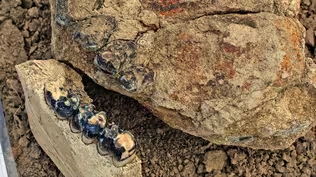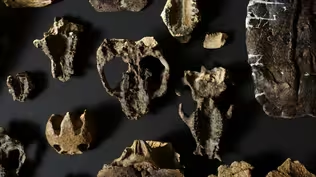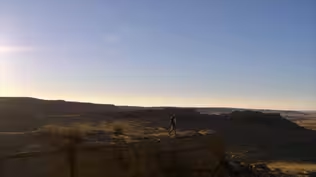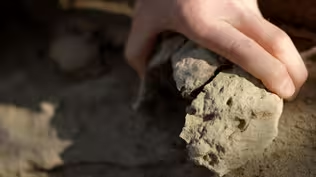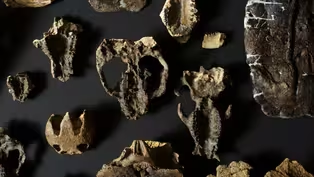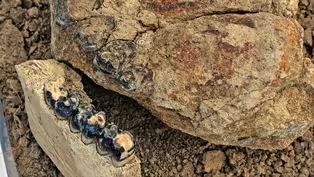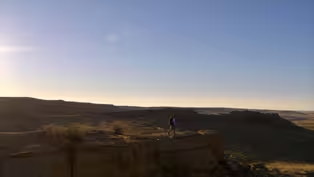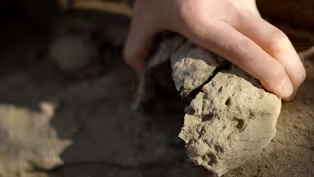
Rise of the Mammals
Season 46 Episode 17 | 53m 15sVideo has Closed Captions
Amazing fossils reveal how mammals took over after an asteroid wiped out the dinosaurs.
Sixty-six million years ago, an asteroid wiped out the dinosaurs in a fiery global catastrophe. But we know little about how their successors, the mammals, recovered and took over the world. Now, hidden inside ordinary-looking rocks, an astonishing trove of fossils reveals a dramatic new picture of how rat-sized creatures ballooned in size and began to evolve into the vast array of species.
Problems playing video? | Closed Captioning Feedback
Problems playing video? | Closed Captioning Feedback
National Corporate funding for NOVA is provided by Carlisle Companies and Viking Cruises. Major funding for NOVA is provided by the NOVA Science Trust, the Corporation for Public Broadcasting, and PBS viewers.

Rise of the Mammals
Season 46 Episode 17 | 53m 15sVideo has Closed Captions
Sixty-six million years ago, an asteroid wiped out the dinosaurs in a fiery global catastrophe. But we know little about how their successors, the mammals, recovered and took over the world. Now, hidden inside ordinary-looking rocks, an astonishing trove of fossils reveals a dramatic new picture of how rat-sized creatures ballooned in size and began to evolve into the vast array of species.
Problems playing video? | Closed Captioning Feedback
How to Watch NOVA
NOVA is available to stream on pbs.org and the free PBS App, available on iPhone, Apple TV, Android TV, Android smartphones, Amazon Fire TV, Amazon Fire Tablet, Roku, Samsung Smart TV, and Vizio.
Buy Now

NOVA Labs
NOVA Labs is a free digital platform that engages teens and lifelong learners in games and interactives that foster authentic scientific exploration. Participants take part in real-world investigations by visualizing, analyzing, and playing with the same data that scientists use.Providing Support for PBS.org
Learn Moreabout PBS online sponsorshipNARRATOR: It's the worst day in the history of life on Earth.
A cataclysm that ends the age of the dinosaurs.
♪ ♪ LINDSAY ZANNO: If they hadn't met their destruction, our story never would have begun.
NARRATOR: From the ashes, a band of survivors rises to become bigger... nimbler... and smarter than any that came before.
Our tribe-- the mammals.
It was only after we lose the dinosaurs that mammals really explode into the diversity of forms that we see today.
♪ ♪ NARRATOR: What happened after the impact?
♪ ♪ How did life surge back?
The clues have been elusive.
IAN MILLER: You could go your entire career and not find a skull from this time period.
That's how rare they are.
NARRATOR: But now comes a remarkable discovery.
SHARON MILITO: There's just nothing like picking up something and finding out it's something amazing.
NEIL SHUBIN: It's like winning the lottery.
TYLER LYSON: Bam!
We hit it big.
NARRATOR: An unprecedented trove of fossils reveals a turning point in the history of life.
KIRK JOHNSON: That moment of rapid mammal evolution is effectively the trigger to our existence here on planet Earth.
♪ ♪ NARRATOR: "Rise of the Mammals"-- right now, on "NOVA."
♪ ♪ ♪ ♪ NARRATOR: We live in the age of mammals.
All across the globe, they thrive in an astonishing array of forms... ♪ ♪ From the great beasts of the forests to giants that sound the ocean depths... ♪ ♪ to us, mammals dominate the planet.
(grunting) But it wasn't always this way.
(dinosaur screeches) For 150 million years, mammals lived in the shadows of the dinosaurs.
Then, a catastrophe gave them an opening.
(explosion thunders) For years, we've known just bits and pieces about how mammals seized the moment and made our story possible.
But now that's changing.
♪ ♪ An extraordinary discovery in Colorado is revealing an unparalleled collection of fossils from the time when mammals began their reign.
♪ ♪ This hoard lay hidden in plain sight until a young fossil hunter made a once-in-a-lifetime discovery.
♪ ♪ LYSON: I grew up in a town of about 80 people, basically the middle of nowhere in southwestern North Dakota.
♪ ♪ NARRATOR: Tyler Lyson's home might look like other outposts scattered across the American West, but this place is unique.
LYSON: Right by my hometown, about a mile away, are badlands that preserve the very last moment of time when dinosaurs were alive.
As a child, I would run around the badlands and find dinosaur bone after dinosaur bone, just tons of dinosaur bones just tumbling out of the hills.
♪ ♪ NARRATOR: Known as the Hell Creek formation, this was the first place T. rex fossils were discovered a century ago.
♪ ♪ Ever since, bone diggers have been searching for more traces of that lost world.
♪ ♪ (helicopter rotors whirring) Even as a boy, Tyler was in the thick of it.
JOHNSON: Years ago, I met a kid named Tyler Lyson.
And he was this gangly 12-year-old kid.
By the time he was 13, he was going out by himself and finding amazing fossils.
He found an entire dinosaur when he was, like, 14 years old.
NARRATOR: Tyler even discovered a new species of feathered dinosaur.
JOHNSON: He became sort of this dinosaur wunderkind.
NARRATOR: It was a made-for-TV story.
MAN: High school sophomore Tyler Lyson has walked just about every inch of this land, and has already headed 20 dinosaur excavations.
NARRATOR: His most spectacular find?
A dinosaur fossil with preserved skin and muscle.
He kept finding more fossils, and soon became an expert in ancient turtles.
He became fascinated by a well-known pattern in where dinosaurs were and where they weren't.
LYSON: I remember as a child crossing over this band and getting above that area and not finding any dinosaurs.
NARRATOR: The distinct layer seemed to mark their disappearance.
LYSON: So, this always fascinated me.
Why, above that boundary, were there no more dinosaurs?
♪ ♪ What happened here?
NARRATOR: The boundary layer, Tyler learned, was the signature of an event that changed the world forever.
(roars) ♪ ♪ During the age of reptiles, dinosaurs tower over mammals.
Other reptiles rule the skies and seas.
They take on a wide range of shapes and lifestyles.
Many are gigantic.
Mammals had been around for millions of years.
But in all of that time, most grew no bigger than a rat.
Then, 66 million years ago, the cataclysm.
♪ ♪ A chunk of rock over six miles wide tears through the atmosphere and slams into the planet.
(collision thunders) The asteroid blasts a crater 20 miles deep and over 100 miles wide in the Yucatan Peninsula.
(dinosaurs screeching and rumbling) It showers the planet with molten rock and white-hot beads of glass.
(dinosaurs screeching and rumbling) LYSON: And this broils the surface of the Earth.
NARRATOR: Creatures on the surface roast.
(creatures roaring) Skies across the globe darken.
Fire gives way to frost.
ANJALI GOSWAMI: You have intense global cooling.
You're talking about immediate global winter.
NARRATOR: Deprived of sunlight, plants wither.
Lush forests collapse.
So the animals that rely on those plants for food, the animals that rely on those animals that rely on plants for food, they would all suffer.
♪ ♪ You really are having the entire food chain fall apart.
NARRATOR: All of the dinosaurs, except the birds, perish.
SHUBIN: Three out of four species that were alive on the planet before the impact died.
And that's just the species.
About 90% of the creatures that were alive before the impact are dead afterwards.
ZANNO: We think about the loss of dinosaurs, but dinosaurs weren't the only animals to suffer from this.
Many, many groups of organisms took a very serious hit, including mammals.
♪ ♪ LYSON: It's a really bad time for life on Earth.
Yet some things survive, right?
Including some of our earliest, earliest ancestors.
♪ ♪ NARRATOR: We don't know much about these creatures.
♪ ♪ None was bigger than a squirrel.
And their size and scarcity have made their fossils hard to come by.
Yet somehow, this band of survivors and their descendants will claim the Earth.
(birds twittering) ♪ ♪ (animals grunting and chittering) LYSON: Today, there are over 6,000 species of mammals.
♪ ♪ And they range in size from the tiny pygmy jerboa, which weighs about as much as a coin, to the largest animal to have ever lived, the blue whale, which is about 180 tons, the size of 15 school buses.
GOSWAMI: Over the last 66 million years, they've evolved an incredible diversity of forms.
♪ ♪ SHUBIN: Mammals today live in almost every environment on the planet, from the tops of the highest mountains to living in the trees, to living in the water.
♪ ♪ NARRATOR: They thrive in scorching deserts and across the frozen tundra.
Mammals even patrol the depths of every ocean and the moonlit reaches of the sky.
♪ ♪ LYSON: All this diversity can be traced back to those survivors of the extinction.
♪ ♪ NARRATOR: What happened in the wake of that catastrophic impact?
LYSON: That's what I'm interested in.
♪ ♪ How long did it take for ecosystems to recover?
For habitats to reform?
For life to get big again?
♪ ♪ NARRATOR: The answers require fossils.
But such relics are rare.
JOHNSON: I've spent much of the last 35 years looking at rocks from the first million years after the extinction of the dinosaurs.
I've studied the fossil plants from that time period.
And through that entire 35 years, I think I've found one or two fossil mammal pieces.
And I'm looking.
I'm out there looking, and I know how rare those things are.
NARRATOR: For years, Tyler and others search for these scarce specimens in North Dakota.
He targets the rock above the boundary layer-- sediments laid down just after the impact.
♪ ♪ Fossil hunters had occasionally found mammal traces here, but Tyler has no such luck.
JOHNSON: Small animals get broken up into fragments.
So, when you're looking for an early mammal, you're looking for effectively the tooth of a mouse-sized animal.
You're looking for something that's about the size of the head of a pin.
And they're excruciatingly hard to find.
♪ ♪ LYSON: Every year, I go back to my hometown, and every year, I spend time above the boundary looking for fossils.
And I've found so few fossils, it's, it's pathetic.
♪ ♪ And I was starting to think about, like, "Well, where's the next area?"
I was getting ready to give up.
NARRATOR: But then, Tyler gets a job-- and another shot-- in Colorado.
He joins up with Ian Miller, an expert in plant fossils at the Denver Museum of Nature and Science.
Ian shares an interest in the extinction and its aftermath, and knows Colorado is a great place to search.
♪ ♪ We have this really unparalleled record of this period of time here in Western North America.
But the best place is right here.
NARRATOR: Together, they start exploring locations around the state.
♪ ♪ One, called Corral Bluffs, offers 400 feet of exposed rock rising above the boundary.
Tyler begins by scanning the ground for bits of bone.
LYSON: That's how we're trained to find fossils-- looking for actual scraps of bone on the surface, or to see bones sticking out of the ground.
NARRATOR: But at Corral Bluffs, this approach yields just a few scattered fragments.
LYSON: I really didn't find a whole lot.
You can only look for fossils for so long before you get really frustrated and decide to go home.
NARRATOR: What Tyler doesn't know is that a museum volunteer had already found the key to his quest in this same spot.
♪ ♪ Long before Tyler arrived in Colorado, Sharon Milito set off to look for fossils from the plateau atop the bluffs.
MILITO: When we first came out, we were just looking for whatever we could find.
The important thing we wanted to find were mammal jaws and mammal teeth, but they were elusive.
So, one day, I was walking along in an area I'd been many times before, and I saw this white, round rock sitting there on kind of its own little pedestal.
♪ ♪ And I picked it up and looked at it, and as soon as I looked at it, I saw these teeth that were just smiling out at me.
And I just almost had a heart attack.
NARRATOR: She'd found part of a mammal skull-- one that could fit in the palm of her hand.
MILITO: I was so excited, because it was really, really well preserved.
♪ ♪ NARRATOR: She brought the fossil to the museum, where it was catalogued and filed away.
♪ ♪ It was years before Tyler happened across it.
LYSON: I was downstairs, just looking through the collection, pulling open drawers, and there, sitting right in the front, was the palate of a mammal.
And I was absolutely astonished; I couldn't believe it.
And so I was sort of thinking to myself, like, "If there's this complete of a skull here, there's got to be more."
NARRATOR: Sharon's fossil had been found in a particular kind of rock called a concretion.
Sometimes, concretions can form around organic material, like bone.
And if conditions are right, they protect the fossil inside for eons.
LYSON: Sharon's skull was incredibly lucky because it showed that, yes, there are fossils inside, and this is the type of rock to look for.
♪ ♪ NARRATOR: Tyler decides to change his game and look for concretions to crack open.
(Tom Petty's "Runnin' Down a Dream" playing) LYSON: It was absolutely a light bulb moment.
That was the game changer.
(song continues) PETTY: ♪ It was a beautiful day ♪ ♪ The sun beat down ♪ ♪ I had the radio on ♪ ♪ I was drivin' ♪ ♪ The trees went by ♪ ♪ Me and Del were singin' "Little Runaway" ♪ ♪ I was flyin' ♪ ♪ Yeah, runnin' down a dream ♪ ♪ That never would come to me ♪ MILLER: Tyler started to put these pieces together, thinking about this new lens to look for these concretions.
(song continues) PETTY: ♪ Runnin' down a dream ♪ Just saying, like, "We're going to go down there, blow the doors off this thing."
Nobody believes him, right?
And even me, who, his colleague, I'm just, like, "That sounds good, that sounds good, man."
(song continues) (song ends) NARRATOR: They hit the bluffs, their eyes peeled for promising rocks.
♪ ♪ There's a whole hillside of choices.
One catches Tyler's eye.
LYSON: I see this rock, this concretion on the ground, the very first one that I pick up, and I crack it, and it was amazing.
I just found a mammal skull!
(laughs) NARRATOR: And that was just the beginning.
MILLER: It was, it was crazy the way it happened.
I mean, you could go your entire career as a mammal paleontologist and not find a skull from this time period-- that's how rare they are.
LYSON: We found, I think, five or six mammal skulls within about a ten-minute time span.
MILLER: We were just laughing on the outcrop.
Nothing like that's ever happened to me before.
I mean, amazing.
NARRATOR: They'd cracked the case... ♪ ♪ ...and unearthed a trove of time capsules filled with clues.
♪ ♪ JOHNSON: It was like opening a door into a new world.
NARRATOR: In the months that follow, Tyler and Ian scour the bluff and discover thousands of fossils, including plants, reptiles, and dozens of mammals.
(laughing) NARRATOR: All of them lived here just after the mass extinction.
GOSWAMI: Most of the time, you know, we're pretty happy if we find some nice teeth from an area that's that close to the boundary.
Having this kind of record is really rare.
You got the other side a little bit, too?
NARRATOR: They had found their quarry at last.
But the really hard work now lay ahead-- figuring out how mammals and their world rose from the ashes.
♪ ♪ What creatures had they unearthed?
What was their strange world like?
♪ ♪ And how did they establish a foothold in a planetary wasteland?
♪ ♪ To answer these questions, Tyler and Ian needed to assemble a crack team of experts.
ZANNO: The fossils are not just the biological remains of animals.
They are also buried in a geological system, and so no one person can really understand all the data that we can get from a fossil.
We need experts to really be able to piece together what the entire ecosystem would have looked like.
NARRATOR: Each fossil contains a wealth of information, but it's hidden in the rock.
The first step is to free it.
So, they reach out to a virtuoso.
ROBERT MASEK: I love working on fossils.
It's so rewarding when you start a fossil and, that you really can't see.
It's, it's almost like a piece of art, sometimes, and it also is contributing to scientific knowledge.
(tool buzzing) NARRATOR: Bob Masek spent his early career working in factories, but he found he had a knack for releasing captives from rocks.
MASEK: When I was little, I used to work on models.
So, I did learn to do detailed work.
It was sort of in me.
My contribution as a preparator is to make the fossil readable so it can be used for science.
GOSWAMI: And you can imagine, you have to be incredibly careful that you don't break your fossils while you're doing that, or even shape them with your own ideas of what they should look like.
NARRATOR: The painstaking process can take months for a single fossil.
But it reveals secrets held tight for millions of years.
MASEK: As you're working, you do start to realize that this was a living animal, a living thing.
I'm bringing it sort of back to life.
♪ ♪ NARRATOR: One by one, the fossils emerge.
Each is exquisitely preserved.
But what are they, and what do they reveal about the mammals' rise?
♪ ♪ LYSON: Stephen Chester is a vertebrate paleontologist who specializes in mammals.
So when I made this discovery, I needed to bring him on board to help me identify all these mammals that I was finding.
NARRATOR: Stephen examines each fossil to find details that reveal what it's related to.
Not an easy job so far back on the mammalian family tree.
CHESTER: We're talking about species that can be very difficult to identify, because they don't look exactly like what you might expect for, for living mammals.
♪ ♪ NARRATOR: It's a common problem in tracing ancestry.
Consider how different an elephant is from a hyrax, or a manatee.
GOSWAMI: You might not think that they are closely related.
They are incredibly different animals.
But their DNA shows us that they are actually really closely related.
♪ ♪ NARRATOR: Descendants of a common ancestor don't always look like each other, or the ancestor, because they've evolved in their own directions for millions of years.
But they're bound to share some common traits.
That's why Stephen examines each skull feature by feature.
His first task is to figure out what kind of mammal they've unearthed.
(birds chirping) All mammals share a few key features.
They're warm-blooded, grow hair, and have bigger brains than other animals their size.
They also give their young a jump start in life by nursing them.
But how they have these babies sets them apart.
Some, like kangaroos and opossums, use a pouch to bring their embryos to term.
A handful-- platypuses and echidnas-- lay eggs.
(chitters) But what about the biggest group of mammals alive today-- those that carry their offspring in the mother's womb?
Like us, they're called placentals.
And they include the mammal Stephen examines from Corral Bluffs.
It's one of the oldest placental fossils ever discovered.
A creature called loxolophus.
It's not yet clear if it has any living descendants.
But the fossil hints at a highly adaptable creature.
CHESTER: This mammal is probably about the size of a skunk.
It has teeth in the front of its mouth that are probably good for tearing meat, but the back of its mouth has other teeth that would be better at processing plants.
It's probably eating a mixed diet.
NARRATOR: This versatility would have been a great advantage in a recovering world, where the types of food were probably limited.
Team member Karen Cuevas finds other insights about how it lived by peering inside the fossil.
CUEVAS: When I first heard about how mammals became what they are today, I was really excited to see how much we could deduce from these fossils and paint this picture from so many million years ago.
One of the things that we can do with the CT scan is view the inner anatomy.
ZANNO: CT reconstructions give us insight into tissues that aren't preserved, and teach us a lot about what those animals were really like as living, breathing creatures.
NARRATOR: The data help the team imagine what the living animal was like.
CHESTER: Based on CT scans, this animal had a hole underneath its eye.
NARRATOR: A passage for nerves from sensitive whiskers.
CHESTER: It also has a large portion of its brain dedicated to the sense of smell.
♪ ♪ NARRATOR: These senses would have been key to its lifestyle in this new world.
Details from related species suggest how it walked.
CHESTER: We would assume that this animal was moving around on the ground on all fours, probably something like a raccoon.
(chittering) NARRATOR: It's a lot to have learned about one of the creatures that roamed the new world.
But Corral Bluffs is about to reveal something even bigger.
LYSON: The discovery here extends well beyond any one particular fossil.
Here, we're dealing with the recovery of an entire ecosystem.
♪ ♪ NARRATOR: If the team can determine the age of each fossil, they can start to see how the mammals evolved over time, and how their world changed alongside them.
GOSWAMI: When we find some interesting fossils, then the next thing that we do is spend a huge amount of effort trying to figure out exactly how old they are.
But getting accurate dates on fossil sites is incredibly hard.
NARRATOR: To estimate the age of their fossils, Tyler and Ian reach out to specialists.
(people talking in background) Geologists Will Clyde and Anthony Fuentes.
Their goal: determine the age of each layer in the rock by building a timeline up the cliff.
To do it, they'll rely on clues forged by planetary forces.
♪ ♪ Earth is surrounded by a magnetic field, which creates north and south magnetic poles.
These may seem permanent, but they're not.
From time to time, the field reverses.
And so what is today the magnetic north for the Earth sometimes flips and becomes the magnetic south.
♪ ♪ NARRATOR: Some rocks can record the direction of the magnetic field at the time they form.
As these build up on top of each other, they can capture a record of magnetic reversals over time.
The date of each flip has been firmly established in rocks across the world.
CLYDE: Four, five... Four, five.
CLYDE: So if we can find certain flip-flop in the polarity in the rocks here, then we know the date of that change.
Six-four.
To the east.
NARRATOR: To look for these flips, they collect rocks along the bottom of the bluffs, where the impact boundary is, and work their way up.
They then bring each sample back to their lab to measure its magnetic orientation.
NARRATOR: Near the bottom of the bluffs, they find a flip from 350,000 years after impact, and trace it across the land.
But a single date isn't enough.
MILLER: If you get one date in a pile of rocks, you know where that one date is.
But above it, you don't know how fast the rocks are accumulating.
There could be a ton of rock in a short period of time, or it could be a small amount of rock in a long period of time.
♪ ♪ NARRATOR: Most of the bluffs, and the team's discoveries, lie above the flip they've found.
They need a second one higher up to bracket the dates of their fossils.
They work their way up, one layer after another.
MILLER: As we went up the hill, you know, you're sampling, you're sampling, but there's no flip, there's nothing, and we're just running out of rock.
NARRATOR: They test samples right up to the top.
Still... No flip.
No way to place their discoveries in time.
♪ ♪ Then, they find a small outcrop perched above the rest of the bluffs.
It's one last chance to catch the flip.
♪ ♪ And it delivers.
♪ ♪ They've found the second date they need.
MILLER: That allowed us to place all these fossils in this incredible time frame.
We had the whole thing, and that was a shock.
We didn't expect that.
We thought we might be missing a part of the record, but it's all there.
♪ ♪ NARRATOR: The towering face of the bluffs chronicles the first one million years of the recovery.
SHUBIN: If you were to choose any one-million-year sliver of time in the four-and-a-half- billion-year history of Earth, it's an enormously lucky event to have one that happens right after a giant asteroid impact.
It's like winning the lottery.
♪ ♪ NARRATOR: Now all the extraordinary fossils of Corral Bluffs can be placed in time.
But what story do they tell?
Another fossil reveals a turning point.
♪ ♪ LYSON: In the middle part of the bluffs, I found a much larger skull.
NARRATOR: This creature lived 300,000 years into the recovery.
LYSON: What's interesting about it is that it has these really large teeth.
NARRATOR: Mammals today use teeth like these to grind leaves and stems.
It suggests this creature dined mostly on plants.
LYSON: And this is really the first major specialization that we see in the mammal fossil record right after the extinction of the dinosaurs.
NARRATOR: Just after the impact, the mammals that survived had been opportunistic scavengers.
But now, mammals were specializing in eating plants and seizing a niche long held by dinosaurs.
♪ ♪ It's a major milestone.
But how did it happen?
The answer could lie in the story of the plants themselves.
And Colorado's rocks are packed with clues.
MILLER: A lot of leaves.
But just two species right here.
NARRATOR: Some leaves are so beautifully preserved, they look as if they had just fallen.
♪ ♪ But other telling fossils are invisible to the naked eye.
Like pollen.
A thimble-sized chunk of rock, it might have 100,000 pollen grains in it.
Each of the different kinds of trees, the little shrubs, produce different kinds of pollen based on who they are.
NARRATOR: Ian and scientists around the world have documented the microscopic record from this time.
♪ ♪ MILLER: Take a chunk of rock, you dissolve it, you take all the pollen spores out of it, put it on a slide, and you see many different types of plants.
And then you can sort of paint this image of what these worlds were like.
♪ ♪ And so right at that mark where we see the evidence of this extraterrestrial impact, the pollen just dives right off.
Everything seems to die.
NARRATOR: After the impact, one primitive form of life resurges, and it's a sign of a devastated world.
MILLER: Right after the boundary, there's an explosion of fungal spores.
The thing is that fungus grows on things that are dead.
So most of the world must have been rotting.
NARRATOR: Forests destroyed by heat and darkness decompose beneath this fungal carpet.
But then some plants rebound.
♪ ♪ MILLER: Following immediately on top of the fungal world, we see a spike in fern spores.
♪ ♪ Ferns are this group of plants that come back after disasters before the rest of the forest is able to re-establish itself.
First thing that comes back are a blanket of ferns.
And that probably lasts for a few thousand years.
♪ ♪ NARRATOR: The world is green again, but ferns are a limited source of food.
New options arise as the landscape evolves, and long-dormant seeds spring to life... A new forest.
MILLER: One of the big surprises was this incredible abundance of palm pollen.
And we get tons of palm fronds-- huge, beautiful palm fronds.
They're so dominant, it feels like the world is all palms.
And it probably lasts about 100,000 years.
What I'm thinking right now is that if you were a mammal, there would have been a big canopy of palms above your head.
But there still wasn't that great source of food.
(insects chirping) NARRATOR: The habitat looks lush, but still lacks diversity.
That, in turn, limits the variety of animals, as a close look at the team's fossils reveals.
When there's an extinction, it kind of ripples from the bottom of the ecosystem, starting from the plants, up into all of the other levels.
NARRATOR: Gussie Maccracken deciphers what happened to some of the smallest creatures: insects.
Insects don't fossilize well, but what they do to plants can.
MACCRACKEN: Insect damage on a leaf can tell us about the ecology of the ecosystem in the past in a way that no other types of fossils can.
NARRATOR: Some insects are generalists, and feed on many types of leaves.
They carve signature marks that can be preserved in fossils.
♪ ♪ Simple holes, or chunks bitten from the leaf's edge.
♪ ♪ But other kinds of damage are caused by insects that specialize in certain plants.
MACCRACKEN: They leave these wild patterns and we can tell things like if it's a moth, or if it's a fly, or sometimes a beetle.
NARRATOR: Before the asteroid struck, the insect world was filled with specialists.
But that changes abruptly.
MACCRACKEN: During recovery, a lot of the specialist insect damage types, like from leaf miners and galling insects, just disappear.
♪ ♪ NARRATOR: The specialists were doomed.
In a world with only a few kinds of plants, insects that can live on anything have an advantage over pickier eaters.
It echoes what happened to the mammals.
Only the generalists survive.
ZANNO: At the time of an extinction event, any species that's highly dependent on a single lifestyle or a single location or a single food source is likely going to go extinct when those ecosystems collapse.
♪ ♪ NARRATOR: But in time, new plants arise and chances to specialize return.
MILLER: The forests become more and more diverse.
We get different kinds of trees growing on the landscape.
♪ ♪ NARRATOR: 300,000 years after its collapse, the forest has recovered.
♪ ♪ MILLER: And it's right there when the animals can specialize in eating certain kinds of plants.
NARRATOR: And get bigger.
These new plant-eaters were now larger than mammals had ever been in over 100 million years on the planet.
♪ ♪ They've shattered their record in just a fraction of that time.
And their growth spurt was just beginning.
LYSON: In the very upper part of the bluffs, I started to find a whole array of large and diverse mammals.
One of the mammals that we found is called taeniolabis.
This is about 80 pounds, so really a large animal.
NARRATOR: It was ten times the size of the omnivore they'd found earlier.
LYSON: It had these really big incisors, much like modern-day beavers have.
We think this animal was living in or near the rivers, because we only find this animal in riverine sediments.
♪ ♪ NARRATOR: Near this fossil, Tyler finds the skull of an even bigger mammal.
LYSON: This is a large animal that was about 100 pounds, so almost the size of a wolf.
And this animal had really big, flat back teeth, and it seems to be eating seeds and other plants.
NARRATOR: In less than a million years since the extinction, mammals have exploded from just a couple of pounds.
Some are 50 times bigger.
It would take nearly 20 million years to make such a leap again.
But what might have fueled this dramatic change?
An intriguing clue lay just a few feet from the beasts' remains.
(kids talking in distance) Ian was leading a group of teens studying at the museum for the summer.
Probably about...
I'd say about the same... MILLER: We were doing all kinds of different things, and it wasn't a terribly exciting site.
A lot of fossils people hand you are just sticks.
So, a lot of people are just, like, "Oh, this is an incredible fossil!"
I'm, like, "Yeah, it's just a stick," you know, "throw that back."
But this one student, her name is Aeon.
We're thinking about moving on, and going somewhere else, and she hands me this rock and she's, like, "What's this?"
Did you get something?
I don't know.
And so I took it up, looked at it in the light, and lo and behold, it was the middle part of a bean pod.
Um, I found this legume two seconds ago from this rock that's sitting in my lap.
MILLER: Right here, 700,000 years into the recovery.
This is the earliest record of the legume family ever in the fossil record.
So that's pretty cool.
NARRATOR: Aeon's legume was alive right at the time when mammals' size was exploding.
A new food for a new world.
♪ ♪ Legumes are very special plants.
Today, there are almost 20,000 species of them, including peanuts, lentils, and soybeans.
Their signature pods are packed with nutrients.
♪ ♪ MILLER: Legumes are like these protein bars for the mammals on the landscape, and at that same moment, we see all these new and large mammals, and we think that they're taking advantage of this new food source.
NARRATOR: Taken together, the many fossils of Corral Bluffs suggest plants were helping to drive mammal evolution.
And a final piece of evidence reveals how plants, in turn, were being driven by something else.
♪ ♪ Ian uncovers clues to one of the planet's most powerful forces-- climate.
He zeroes in on the shape of the leaves he's unearthed.
MILLER: The more species you have with serrations, the cooler it is; the more smooth leaves you have, the warmer it is.
And so we can use that to tell temperature in the past.
♪ ♪ NARRATOR: The size of the leaves can reveal rainfall.
(thunder booms) MILLER: If you've got a really big leaf, it means that you're growing in a world that rained a lot, and so the forest was really dense.
NARRATOR: Most of the fossil leaves from Corral Bluffs are smooth and large.
Together, they paint a picture of a very different Colorado 65 million years ago.
♪ ♪ MILLER: We're probably looking at a world that's more like Florida.
It's pretty wet, pretty humid, and pretty darn warm.
NARRATOR: This climate shaped the plants and the creatures that evolved here.
♪ ♪ GOSWAMI: No organism evolves or lives in isolation, right?
Everything about them really reflects their interactions with their environment, with other species.
We really need to understand those relationships.
We want to build up a picture of how life evolved in this period.
♪ ♪ NARRATOR: In the first two years after Tyler and Ian made their find, their team collected over 1,000 vertebrate fossils.
♪ ♪ Some 6,000 plants.
♪ ♪ And the end is nowhere in sight.
♪ ♪ LYSON: The discovery at Corral Bluffs is remarkable for many reasons.
We have the whole ecosystem, and we have it at different intervals of time.
I mean, we're dealing with the entire story here.
NARRATOR: So far, that story includes 16 different mammal species they've found.
It's an extraordinary record that unites plants, animals, climate, and time in a single picture.
♪ ♪ SHUBIN: So, what Tyler and Ian have discovered is a Rosetta Stone.
And Corral Bluffs is telling us something very important.
It's telling us about ourselves, how we got to be here.
(rock cracks loudly) ♪ ♪ NARRATOR: The team's discoveries, along with other evidence, trace the beginning of the mammals' fateful rise.
♪ ♪ (explosion booms) Few survived the impact winter.
But as the climate warmed, plants regained lost ground.
Small creatures endured, eating whatever they could find.
Forests recovered, and fueled mammals as they exploded in size and took on new forms... All in less than a million years.
♪ ♪ In the ages that followed, mammals seized empty niches.
(large cat growls) Our ancestors scaled the trees.
Others took to the air, or became giants of the seas.
Mammals rose to dominate the planet.
♪ ♪ All this diversity sprang from the band of humble creatures that emerged from the cataclysm.
♪ ♪ JOHNSON: They inherited a whole world and they had the planet to play in.
And that moment of rapid mammal evolution is effectively the trigger to our existence here on planet Earth.
♪ ♪ NARRATOR: By unveiling the start of the mammals' explosion, Corral Bluffs seems destined to join the ranks of other celebrated fossil sites, like Tyler's back yard in North Dakota.
LYSON: I can trace those same questions that I'm asking today out on the bluffs all the way back to when I was six or seven years old, running around the badlands looking for fossils.
NARRATOR: By pursuing those questions, Tyler and his colleagues are helping us understand how the planet recovered from catastrophe.
They're illuminating the dawn of a new world.
Our world.
♪ ♪ ♪ ♪ ♪ ♪ ♪ ♪ ♪ ♪ ♪ ♪
How Fossilized Plants Tell Us About the Evolution of Animals
Video has Closed Captions
Clip: S46 Ep17 | 1m 34s | Plants can help us understand how life rebounds after a mass extinction. (1m 34s)
Mammal Fossils Fill in Missing Piece of the Timeline of Life
Video has Closed Captions
Clip: S46 Ep17 | 3m 35s | This trove of mammal fossils paints a timeline of life after the dinosaurs died. (3m 35s)
Paleontologist Makes "Game-Changing" Fossil Discovery
Video has Closed Captions
Clip: S46 Ep17 | 1m 34s | The Denver Basin preserves a pristine record of ecosystem recovery. (1m 34s)
Paleontologists Discover New Mammal Fossils Hidden in Rocks
Video has Closed Captions
Clip: S46 Ep17 | 5m 44s | Stunning new mammal fossils were hiding in plain sight. (5m 44s)
Video has Closed Captions
Preview: S46 Ep17 | 26s | Amazing fossils reveal how mammals took over after an asteroid wiped out the dinosaurs. (26s)
Providing Support for PBS.org
Learn Moreabout PBS online sponsorship
- Science and Nature

Capturing the splendor of the natural world, from the African plains to the Antarctic ice.













Support for PBS provided by:
National Corporate funding for NOVA is provided by Carlisle Companies and Viking Cruises. Major funding for NOVA is provided by the NOVA Science Trust, the Corporation for Public Broadcasting, and PBS viewers.


